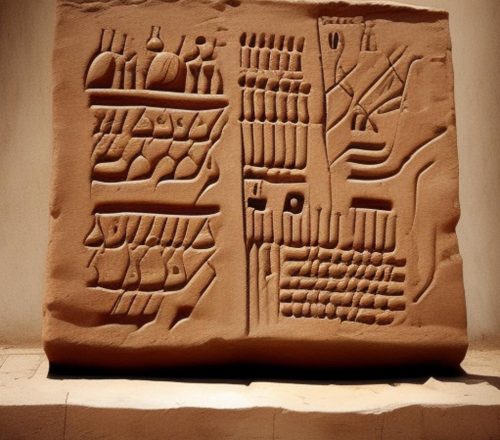
Table of Contents
Unveiling the Lost World of Atlantis
The vast Sahara Desert, stretching across North Africa, holds many secrets beneath its golden sands. Among its mysteries lies the Richat Structure, also known as the Eye of the Sahara. This massive, circular geological formation has captivated scientists and explorers alike. Some theorists believe it to be the remnants of the legendary Atlantis, a once-great civilization described by the ancient philosopher Plato. Could the Eye of the Sahara be the long-lost Atlantis, now sunken into the desert sands? Let’s delve into the geological and historical evidence to explore this captivating possibility.
The Geological Marvel of the Richat Structure
The Richat Structure, located in Mauritania, is an impressive geological formation that spans approximately 40 kilometers in diameter. From space, it appears as a giant bullseye amidst the barren desert, with its concentric rings and central plateau. Initially thought to be an impact crater, scientists have since determined that the structure is the result of an uplifted geologic dome, sculpted by millions of years of erosion (HowStuffWorks) (livescience.com) .
The formation consists of various types of rocks, including sedimentary, igneous, and metamorphic. Studies have revealed that the central part of the structure is composed of brecciated limestone and dolomite, while the outer rings are made up of quartzite and other resistant rock types (Geology Base) . This geological complexity suggests a dynamic history involving volcanic activity, magmatic intrusions, and significant erosion.
Plato’s Atlantis = A Civilization Lost to Time
In his dialogues “Timaeus” and “Critias,” Plato describes Atlantis as a powerful and advanced civilization that existed around 9,000 years before his time. According to Plato, Atlantis was a large island located beyond the “Pillars of Hercules” (commonly identified with the Strait of Gibraltar) and possessed a unique circular layout with concentric rings of land and water. The Atlanteans were said to be wealthy, with an abundance of resources, magnificent temples, and palaces adorned with gold and silver.
However, as the Atlanteans grew greedy and power-hungry, they incurred the wrath of the gods, leading to their downfall. In a single day and night of misfortune, Atlantis was swallowed by the sea, leaving no trace of its existence (HowStuffWorks) (Earthly Mission) .
Linking the Eye of the Sahara to Atlantis
The hypothesis that the Eye of the Sahara could be the remnants of Atlantis is intriguing, given the similarities in descriptions. Proponents of this theory argue that the Richat Structure’s circular design and large size closely match Plato’s account of Atlantis. Furthermore, geological evidence suggests that the Sahara region, which is now a desert, was once a much wetter environment, potentially supporting a thriving civilization (Ancient Origins) (The Ancient Zen) .
Geological studies indicate that the Richat Structure formed during the Cretaceous period, around 100 million years ago, through volcanic and tectonic processes. The concentric rings were created by the uplift and subsequent erosion of different rock layers. This natural formation could have been modified by an ancient civilization to suit their needs, creating a series of canals and waterways, much like the descriptions of Atlantis (Geology Base) (NASA) .
A Sinking World = The Transformation of the Sahara
To further explore the possibility of the Eye of the Sahara being Atlantis, we must consider the transformation of the Sahara region over millennia. Geological evidence shows that the Sahara was once a lush, green landscape with rivers, lakes, and abundant vegetation. This period, known as the African Humid Period, occurred between 14,000 and 5,000 years ago, providing an environment where advanced civilizations could flourish (HowStuffWorks) (livescience.com) .
As the climate changed, the region gradually became more arid, leading to the formation of the vast desert we see today. The shifting sands could have buried the remnants of an ancient civilization, preserving them beneath the surface. If Atlantis did exist in this region, it is conceivable that the catastrophic event described by Plato involved not just submersion by water, but also the encroachment of desert sands, effectively sinking the civilization into oblivion.
Archaeological Evidence and Future Research
Despite the compelling geological and historical evidence, the theory linking the Eye of the Sahara to Atlantis remains speculative without concrete archaeological findings. To date, no definitive artifacts or structures have been discovered that can be directly attributed to the Atlanteans. However, the Richat Structure’s remote location and challenging environment have limited extensive archaeological exploration (Earthly Mission) (NASA) .
Future research and technological advancements, such as ground-penetrating radar and satellite imaging, may uncover hidden evidence beneath the sands. Continued exploration of the region could provide new insights into the history of the Sahara and potentially reveal the secrets of a lost civilization.
A Mythical Connection
The Eye of the Sahara, with its enigmatic concentric rings and awe-inspiring size, continues to captivate the imagination of those who seek to uncover the mysteries of our past. While the hypothesis that it is the lost city of Atlantis remains unproven, the geological and historical evidence presents a tantalizing possibility. Whether or not the Richat Structure is the true Atlantis, it serves as a reminder of the Earth’s dynamic history and the civilizations that may have risen and fallen, leaving only whispers of their existence.
As we consider the sands of time, the Eye of the Sahara stands as a symbol of human curiosity and the enduring quest to uncover the secrets of our world. The story of Atlantis, whether myth or reality, inspires us to look beyond the surface and explore the hidden depths of our planet’s history.
Online resources
Some useful resources on the Eye of the Sahara and its possible link to Atlantis:
- HowStuffWorks provides an in-depth look at the geological formation of the Eye of the Sahara, also known as the Richat Structure. It discusses how the structure, initially thought to be an impact crater, is now understood to be a geologic dome shaped by erosion. The article also covers the unique concentric rings of sedimentary rock that make the structure so visually striking and its formation through terrestrial processes like volcanic activity and erosion (HowStuffWorks) .
- Earthly Mission explores the theory that the Eye of the Sahara could be the site of Atlantis. It details the geological formation’s history and addresses arguments both for and against the Atlantis theory. The article highlights the challenges in matching the structure’s physical attributes with Plato’s descriptions and the lack of archaeological evidence supporting the idea that it was once a city (Earthly Mission) .
- Ancient Origins delves into the scientific significance of the Richat Structure. It covers the geological processes that created the formation and discusses its appeal to both scientists and conspiracy theorists. The article emphasizes the need for further study to fully understand the structure’s origins and its historical significance (Ancient Origins) .
- The Ancient Zen provides an overview of recent research and discoveries related to the Richat Structure. It includes satellite images and discusses the structure’s role in scientific studies of Earth’s geological history, as well as its connection to the Atlantis legend (The Ancient Zen) .
These resources should give you a comprehensive understanding of the Eye of the Sahara, its geological features, and the ongoing debate about its connection to Atlantis.
Scientific papers
There are several scientific studies and articles that explore the Richat Structure, commonly known as the Eye of the Sahara, and its potential connection to the Atlantis myth, as well as its geological significance.
- Geological Formation and Features:
- The Richat Structure is a geologic dome characterized by concentric rings formed by layers of sedimentary rocks. Initially thought to be an impact crater, it is now understood to be the result of a dome uplift caused by volcanic activity, followed by erosion over millions of years. The structure includes igneous rocks like gabbro, rhyolite, carbonatite, and kimberlite (HowStuffWorks) (livescience.com) (Geology Base) .
- Detailed studies have shown that the formation process involved significant magmatic intrusions and volcanic activity, particularly during the Cretaceous period (between 145 and 66 million years ago) (Geology Base) .
- Connection to Atlantis:
- The hypothesis linking the Richat Structure to Atlantis is based on similarities in descriptions, particularly the circular design and the presence of concentric rings. However, this theory faces significant challenges, including the structure’s elevation and lack of archaeological evidence of a once-inhabited city (NASA) (livescience.com) .
- Modern geological and archaeological analyses have not found any evidence supporting the existence of a lost civilization like Atlantis at the Richat Structure. Studies indicate that while the formation is geologically fascinating, it does not match the descriptions of Atlantis as detailed by Plato in his dialogues (HowStuffWorks) (NASA) .
- Scientific Studies and Evidence:
- Research has focused on understanding the geological processes that formed the Richat Structure. Studies highlight its composition of various igneous and sedimentary rocks, the presence of ancient volcanic activity, and the significant erosion that has shaped its current appearance (livescience.com) (Geology Base) .
- The structure has also been of interest to space agencies like NASA, with astronauts capturing images of it from space due to its distinctive and prominent appearance (NASA) .
For further reading, you can explore these sources in more detail:
- HowStuffWorks on the Richat Structure
- Live Science article on the Eye of the Sahara
- Geology Base overview of the Richat Structure
- NASA’s description and studies on the Eye of the Sahara
These resources provide comprehensive insights into the geological significance of the Richat Structure and the ongoing debate about its connection to the legend of Atlantis.
Shop tips
Happy exploring!
Embark on a journey into the realm of affiliate marketing and craft your own website within a vibrant, supportive community. Join me in this adventure, where you can begin as a free starter and stay as long as you desire. Enjoy complimentary hosting and foundational teachings to set you on your path. For those with advanced skills, opportunities to elevate your expertise await. Take a moment to explore and witness the magic for yourself!




